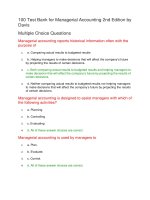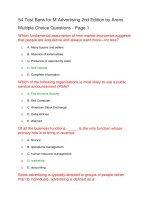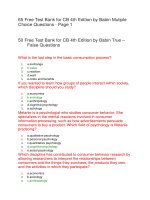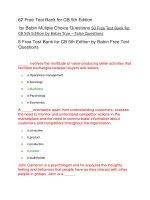88 test bank for consumer behavior 2nd edition by kardes
Bạn đang xem bản rút gọn của tài liệu. Xem và tải ngay bản đầy đủ của tài liệu tại đây (118.1 KB, 22 trang )
88 Test Bank for Consumer Behavior 2nd Edition by
Kardes
True - False Questions
A company's sales records represent primary data.
1.
True
2.
False
Systematic testing and following the Scientific Method can allow
researchers to determine causal relationships with a high degree of
certainty.
1.
True
2.
False
Paul wants to perform a research study to explore how people feel while
they shop for a house. He really wants to be able to describe a person's
emotional experience during this buying process. Paul will probably use
qualitative research methods.
1.
True
2.
False
Qualitative research methods require large representative samples of data
to be valid; thus, their results can typically be generalized to the larger
population of interest.
1.
True
2.
False
Hospitals, schools, and goverrnnent agencies are all considered
organizational consumers.
1.
True
2.
False
In an experiment, participants should be randomly assigned to the
conditions.
1.
True
2.
False
Research has shown that there is relationship between the number of
added features a cell phone has and the level of customer satisfaction,
such that as features go down, satisfaction goes down. This type of
relationship represents a negative correlation.
1.
True
2.
False
A positive correlation means that one variable causes some influence the
other variable.
1.
True
2.
False
Procter and Gamble's Crest Whitestrips, featured in your readings, has
been one of the company's most successful product launches because
the management team relied on intuition to guide their decisions.
1.
True
2.
False
Mall-intercept surveys, in-depth interviews, and focus groups are all forms
of direct questioning in consumer research.
1.
True
2.
False
Consumer behavior researchers are primarily only interested in
consumers' purchase behaviors.
1.
True
2.
False
Recycling aluminum cans, reading a newspaper, and reselling an old
couch at a garage sale are all types of consumer disposal activities.
1.
True
2.
False
Studying how consumers decide to buy products is a good defmition of
consumer behavior.
1.
True
2.
False
An zero correlation means there is no predictable relationship between
two variables.
1.
True
2.
False
Consumer behavior includes consumers' emotional, mental, and
behavioral responses associated with the activities of purchase, use, and
disposal of good and services.
1.
True
2.
False
Researchers at Kraft Foods were interested in how dads prepare dinners
when they use the company's macaroni and cheese product, so they
asked some dads if they could fihn them making dinner. This is an
example of unobtrnsive observation.
1.
True
2.
False
A key benefit of basic research is that conclusions drawn from it can be
generalized across many situations.
1.
True
2.
False
Experimentation is the best method for determining causality.
1.
True
2.
False
An illusory correlation means there is no predictable relationship between
two variables.
1.
True
2.
False
The Scientific Method should only be used in the physical sciences, not in
marketing.
1.
True
2.
False
Consumer behavior researchers are interested in consumer responses,
which include their emotional, mental, and behavior responses.
1.
True
2.
False
Consumer welfare is the establishment of laws and regulations that guide
and govern business practices in order to protect consumers.
1.
True
2.
False
The primary methods of Behavioral Science include the experimental
approach and the marketing science approach.
1.
True
2.
False
The Motivation Research movement left two important legacies to the field
of consumer research: ( 1) a focus on consumer motivations, and (2) the
technique of focus group research.
1.
True
2.
False
Customer perceived value is the consumer's overall assessment of the
utility of a product based on the perceptions of what is given and
received.
1.
True
2.
False
Research has shown that there is relationship between the number of
coupons issued in a market and the level of sales, such that as the
number of coupons issued goes up, sales go up. This type of relationship
represents a positive correlation.
1.
True
2.
False
Executives at McDonald's were curious to know if their new soft-drink cup
design was attractive to customers. Basic research can help them find the
answer to this question.
1.
True
2.
False
If a retailer knows that advertising is highly correlated with increased
store traffic, then he or she can be confident that increased advertising
will cause an increase in store traffic.
1.
True
2.
False
The advantages of secondary data are that the information is specific and
relevant to a specific project, is current, and the data can be controlled.
1.
True
2.
False
Consumer actions that are unhealthy, unethical, or potentially dangerous
to an individual or society are often called "the dark side of consumer
behavior."
1.
True
2.
False
Surveys are useful for collecting specific, often complex information from
a large number of people.
1.
True
2.
False
Customer perceived value is the idea that customer benefits should not
only meet but exceed expectations in unanticipated ways.
1.
True
2.
False
Paula likes to sew quilts. She often collects old clothes from her family
and friends to cut up and use in her quilts. When she does this, Paula is
engaging in a consumer use/consumption activity.
1.
True
2.
False
According to your readings, Procter and Gamble executives believe that
delighting customers during their usage experience with their products
represent "moments of truth"for the company.
1.
True
2.
False
Secondary data are data that already exist and are accessible.
1.
True
2.
False
In an experiment, independent variables are held constant so they can be
controlled.
1.
True
2.
False
Public Policy is the establishment of laws and regulations that guide and
govern business practices in order to protect consumers.
1.
True
2.
False
Individual consumers purchase goods and services to satisfy their own
personal needs and wants or to satisfy the need and wants of others.
1.
True
2.
False
The Interpretivism research approach applies the tenets of the scientific
method to explain and predict consumer behavior.
1.
True
2.
False
Organizations that market products or services often study consumer
behavior in order to improve business performance.
1.
True
2.
False
Focus groups often generate responses that participants would be
unwilling or unable to give in a depth-interview.
1.
True
2.
False
Qualitative research methods collect empirical data and use large
representative samples so that statistical analyses can be performed and
generalization of the results can be made.
1.
True
2.
False
When respondents don't answer a question on a survey honestly or
completely because they feel the information is too personal or
embarrassing, the question is suffering from social desirability bias.
1.
True
2.
False
Torn and Kelly watching a movie they rented. They are engaged in a
consumer purchase activity.
1.
True
2.
False
The cause always precedes an effect.
1.
True
2.
False
During the peak of the Motivation Research movement, Ernest Dichter
performed in-depth interviews for over 200 different product categories.
1.
True
2.
False
The first step in the Scientific Method is to form a hypothesis and make a
prediction.
1.
True
2.
False
Secondary data tends to take longer to collect than primary data.
1.
True
2.
False
Multiple Choice Questions
Donating your old clothes to The Salvation Army is classified as:
1.
a. consumer behavior
2.
b. a disposal activity
3.
c. a consumer response
4.
d. a type of recycling
5.
e. All of the above are correct.
What type of correlation is shown in this graph?
1.
a. An illusory correlation
2.
b. A positive correlation
3.
c. A negative correlation
4.
d. A zero correlation
5.
e. A confounding correlation
purchase goods and services to satisfy their own personal needs and
wants or to satisfy the needs and wants of others.
1.
a. Individual consumers
2.
b. Non-profit organizations
3.
c. Organizational consumers
4.
d. Purchasing agents
5.
e. All of the above are correct.
Which of the following about "Motivation Research" is false?
1.
a. Motivation research is one of the earliest approaches to studying consumer
behavior.
2.
b. Many advertisers embraced motivation research because it could seemingly tap
into deep rooted needs of consumers.
3.
4.
5.
c. This method applied observational and focus group techniques to explore
consumers' motivations.
d. The method of developed by psychologist named Ernest Dichter.
e. Dichter viewed consumers as predominantly immature, irrational and driven by
hidden erotic desires.
entails all consumer activities associated with the purchase, use, and
disposal of goods and services, including the consumer's emotional,
mental, and behavioral responses that precede, determine, and follow
these activities.
1.
a. Public policy
2.
b. Consumer Behavior
3.
c. Marketing
4.
d. Consumption
5.
e. The marketing concept
is the establishment oflaws and regulations that guide and govern
business practices in order to protect consumers.
1.
a. Consumer welfare
2.
b. Consumer behavior
3.
c. Public policy
4.
d. Organizational consumer behavior
5.
e. Consumer endowment
Raymond is visitiog the dentist; he is haviog a wisdom tooth pulled. What
type of consumer behavior activity is Raymond engaged is?
1.
a. Purchase activity
2.
b. Use/consumption activity
3.
c. Communication activity
4.
d. Disposal activity
5.
e. None of the above is correct.
is the idea that fmns should discover and satisfy customer needs and
wants in an efficient and profitable manner while benefiting the long-term
interests of society.
1.
a. Behavioral science
2.
b. Customer delight
3.
c. The marketing concept
4.
d. A selling orientation
5.
e. Interpretivism
include a consumer's affect, feelings, and moods during purchase, use,
and disposal activities.
1.
a. Behavioral responses
2.
b. Mental responses
3.
c. Cognitive responses
4.
d. Emotional responses
5.
e. Social responses
In an experiment, the independent variable is the , and the dependent
variable is the .
1.
a. statistic; control
2.
b. cause; effect
3.
c. effect; cause
4.
d. control; statistic
5.
e. cause; control
Many consumers believe (and some orange juice makers imply in their
advertising) that when it comes to the quality of non-frozen orange juice,
the closer the processing plant is the growing field, the fresher and higher
quality the juice. However, there is no correlational relationship between
these variables. This type of correlation is called:
1.
a. a confounding correlation
2.
b. an illusory correlation
3.
c. a positive correlation
4.
d. a spurious correlation
5.
e. a negative correlation
Jane is on the spring formal organizing committee for her sorority. She
notices that every time they meet to discuss new ideas, they seem to
focus on just one idea. It seem like once an idea is presented, no one
wants to disagree or offer anything different for the sake of unanimity.
Jane's committee is probably experiencing:
1.
a. a lack of clear goals
2.
b. group hypertension
3.
c. group cohesion
4.
d. group stress
5.
e. groupthink
In an experiment, the independent variable is , and the dependent variable
is .
1.
a. manipulated; measured
2.
b. measured; held constant
3.
c. held constant; manipulated
4.
d. manipulated; held constant
5.
e. measured; manipulated
Which of following is not a secondary data source?
1.
a. Past company sales records
2.
b. U.S. Bureau of Census reports
3.
c. Documented results of previous research
4.
d. Magazines like Advertising Age
5.
e. All of the above are secondary data sources.
Consider the Scientific Method discussed in your readings: -- Observation
and Ask Questions --Form a Hypothesis and Make a Prediction What is the
next step?
1.
a. Test the Hypothesis
2.
b. Establish a Budget
3.
c. Generate a Theory
4.
d. Gather Information
5.
e. Choose a Research Method
Research has shown that there is a relationship between a person's shoe
size and their writing proficiency, such that people with larger shoe sizes
tend to have greater writing skill. What type of relationship is this?
1.
a. A causal relationship
2.
b. A positive correlation
3.
c. A zero correlation
4.
d. An illusory correlation
5.
e. A negative correlation
Mike is professor who does research in consumer behavior. He is
interested in frnding out if women are more likely than men to listen to
music jingles in advertising. What type of research will Mike most likely
engage?
1.
a. Focus group research
2.
b. Applied research
3.
c. Secondary data collection
4.
d. Qualitative research
5.
e. Basic research
Consumer behavior researchers are interested in consumer responses.
These responses primarily include which of following:
1.
a. thoughts, beliefs, and cognition
2.
b. feelings, emotions, and attitudes
3.
c. motivation and behavior
4.
d. emotions, cognition, and behavior
5.
e. researchers are really only concerned with behavior
What type of correlation is shown in this graph?
1.
a. An illusory correlation
2.
b. A positive correlation
3.
c. A negative correlation
4.
d. A zero correlation
5.
e. A confounding correlation
Which of the following about projective techniques used in marketing
research are false?
1.
a. Projective techniques often generate responses that participants would be
unwilling or unable to give if questioned directly.
2.
b. Projective techniques originated in the field of psychology.
3.
c. In one class of projective techniques, called completion tasks, subjects fill-inthe-blanks by fmishing sentences or stories.
4.
d. Projective techniques provide the advantages of providing data that is quick to
collect, code, and analyze because the data can be collected using a survey.
5.
e. In expression-type projective techniques, subjects describe the actions of
typical others.
Which of the following is not a use/consumption activity?
1.
a. Watching movie in a theatre
2.
b. Eating an ice cream cone
3.
c. Test-driving a car
4.
d. Getting a haircut
5.
e. Turning on a lamp
include a consumer's overt decisions and actions during purchase, use,
and disposal activities.
1.
a. Behavioral responses
2.
b. Mental responses
3.
c. Cognitive responses
4.
d. Emotional responses
5.
e. Social responses
usually consist of 6 to 12 people involved in a discussion led by a
facilitator who monitors and guides the group discussion.
1.
a. In-depth interviews
2.
b. Observational studies c. Experiments
3.
d. Group studies
4.
e. None of the above is correct
John is tryiog to decide where to attend college. He has researched
several schools online; he has visited three colleges; and he has
discussed his preferences with his family. John is currently engaged io
what consumer activity?
1.
a. Purchase activity
2.
b. Consumption activity
3.
c. Use activity
4.
d. Disposal activity
5.
e. None of the above is correct.
Which of the following is not a benefit of studying consumer behavior?
1.
a. Improving business performance
2.
b. Influencing public policy
3.
c. Educating consumers and helping them make better decisions
4.
d. Helping businesses achieve a selling orientation
5.
e. All of the above are benefits of studying consumer behavior.
purchase goods and services to produce other goods or services, or
resell them, or run their operation.
1.
a. Manufacturers
2.
b. Non-profit organizations
3.
c. Organizational consumers
4.
d. Government agencies
5.
e. All of the above are correct.
Activities through which consumers purchase goods and services,
including all of the search and evaluation activities that lead up to
purchase, are classified as what type of consumer activity?
1.
a. Purchase activity
2.
b. Consumption activity
3.
c. Use activity
4.
d. Disposal activity
5.
e. None of the above is correct.
Which of the following is an example of a negative correlation?
1.
a. As advertising increases, sales increase
2.
b. As advertising increases, sales go either up or down
3.
c. As advertising decreases, sales decrease
4.
d. As advertising increases, sales decrease
5.
e. Both C and D are correct.
attempts to understand cause-and-effect relationships by carefully
manipulating independent variables and controlling constants.
1.
a. Focus groups
2.
b. Observational Studies
3.
c. Experiments
4.
d. Projective Techniques
5.
e. None of the above is correct.
is the systematic process of planning, and then collecting, analyzing, and
interpreting data and information relevant to marketing problems.
1.
a. Consumer behavior
2.
b. The scientific method
3.
c. Secondary data collection
4.
d. Qualitative research
5.
e. None of the above is correct.
What is the most valid criticism of the following question that appears on
a questionnaire given to college students: "Have you ever cheated on an
examination?"
1.
a. It is a leading question.
2.
b. It is an ambiguous question.
3.
c. It has potential for social desirability bias.
4.
d. It is a double-barreled question.
5.
e. It is an open-ended question.
Free Text Questions
What are the primary benefits of studying consumer behavior?
Answer Given
1. Improving Business Performance: Individuals within organizations that market
products and services often study consumer behavior-or use the results and
recommendations of others' research-in order to improve business performance
through customer-focused strategy; 2. Influencing Public Policy: Those interested
in shaping public policy study consumer behavior in order to understand the
public's needs and wants, and at the same time protect the pubic from unfair,
unethical, or dangerous business practices; 3. Educating and Assist Consumers:
Many people study consumer behavior because they want to educate consumers
or help them act responsibly.
Describe the steps in the scientific method.
Answer Given
The steps of the scientific method include: 1. Observation and Asking the
Question: Observations we make in the world around us are the basis for
formulating questions or problems we want to solve; 2. Form a Hypothesis and
Make a Prediction: When a question or problem emerges from observation, we
generate a potential explanation called a hypothesis that might answer the
question. A prediction is what we expect to happen if our hypothesis is correct. 3.
Test the Hypothesis: We test our hypotheses under controlled conditions, such as
testing one hypothesis at a time and limiting the circumstances/environment of the
testing to see if our predictions are correct. 4. Theory Generation: If a hypothesis
is confirmed via testing and re-testing, we generate a theory, which is a general
explanation for our original question. Once a theory is established, it also guides
future research.
Discuss the differences between "Behavioral Science" and
"Interpretivism."
Answer Given
Behavioral science applies the tenets of the scientific method, relying on
systematic, rigorous procedures to explain, control, and predict consumer
behavior. Thus, behavioral scientists study people and their behaviors in the same
way that natural scientists study physical phenomena. Behavioral scientists who
study consumer behavior tend to view consumers as largely rational; they seek
causes for behavior, conduct research to be used for strategic marketing decision
making, and predominantly use quantitative research methods. Interpretivism
approaches approach consumers as more non-rational beings and view
consumers' reality as highly subjective, collecting data to describe and interpret
this reality. Interpretivist consumer researchers often take particular interest in the
consumption experience and stress the benefits of understanding the consumer
from a broader societal perspective. They also tend to reject the quantitative
approach to research methods.
What is the difference between basic research and applied research?
Answer Given
Basic research looks for general relationships between variables, regardless of
the specific situation. The key benefit of basic research is that the conclusions
drawn from it generally apply across a variety of situations, and researchers can
use these generalizations to guide strategic planning and develop marketing
tactics. Applied research, on the other hand, examines many of these same
variables, but within a specific context of interest to a marketer. Applied research
is typically carried out because consumer researchers want to answer a particular
business-related problem of immediate interest.
A recent research study examining prescription drug advertisements
showed that the number of ads shown for a prescription medication
influenced the number of inquiries about the medication that patients
made to their doctors. Is this a correlational or causal relationship or is
there actually no relationship? Justify your answer.
Answer Given
First, we know there is some sort of correlational relationship because the
information provided tells us so. The question tells us the # of ads influences the #
of inquiries the next week. (This implies any change in# of ads (increase or
decrease) (leads to) a change (increase or decrease) in inquiries. While an
argument can be made that the relationship is probably a positive correlational
relationship, this knowledge is irrelevant in justifying the type of relationship. Do
we know if it is causal? In order to be causal, it must meet the following criteria: I)
There is an influential (correlational) relationship; 2) Ads running precede the
coupon requests for the change/influence to occur, and the relationship cannot be
reversed logically; 3) Confounding variables MUST be ruled out. This criteria is
NOT met since the research fmding for the context was not found through the use
of systematic research methods that ruled out confounds.
What can a correlational relationship tell a researcher? What can't it tell a
researcher?
Answer Given
A correlational relationship can tell a researcher how a variable is associated with
another variable. For example, a marketer could learn that advertising and sales
are positively correlated. This would indicate advertising and sales increase (and
decrease) together. Correlational relationships cannot tell the researcher which
variable is causing the other.
Design an experiment to determine ifthere is a causal relationship
between humorous advertisements and brand attitude (reminder: brand
attitude means how much someone likes a brand). Make sure to indicate
the independent and dependent variables.
Answer Given
For this experiment, we should generate a large random sample of our population
of interest and conduct a quantitative data collection, since we are interested in
causality. The independent variable would be the advertisements, one
advertisement that is humorous versus one that is not humorous. The dependent
variable is a measure of brand attitude. To half of the sample, we show the
humorous ad and to half of the sample we show the non-humorous ad. Next we
measure brand attitude. [(We can use a question such as, "Rate the extent to
which you like brand X." with a scale from I (strongly dislike) to 10 (strong like)] To
analyze the data, we would simply compare brand attitudes across the two
independent variables to see if there is a statistically significant difference
between the two groups. In addition, for causality, we need to make sure to hold
the ads as similar as possible to rule out other possible effects and we should
replicate our experiment multiple times.
Identify and define the three primary human responses studied in
consumer behavior research.
Answer Given
Emotional responses (also called affective responses) are a consumer's emotions,
feelings and moods. Mental responses (also referred to as cognitive responses)
include a consumer's thought processes, opinions, beliefs, attitudes, and
intentions about products and serv1ces. Behavioral responses include a
consumer's overt decisions and actions during the purchase, use, and disposal
activities identified above.
What are the conditions for causality?
Answer Given
I. Correlation (association); 2. Temporal order: one event occurs before the other
and the direction cannot be reversed; 3. Ruling-out other variables: no alternative
explanations









